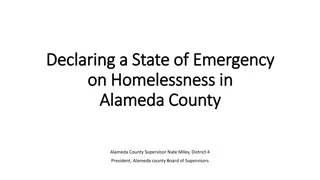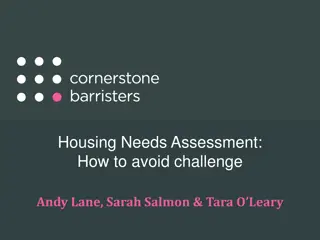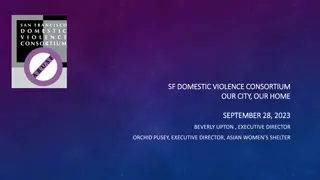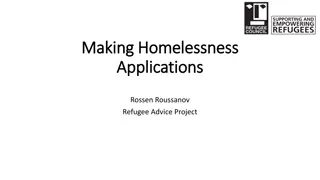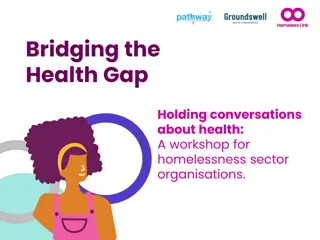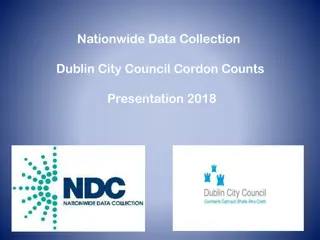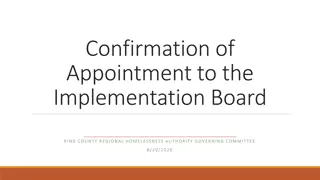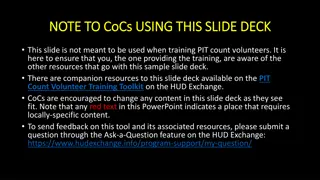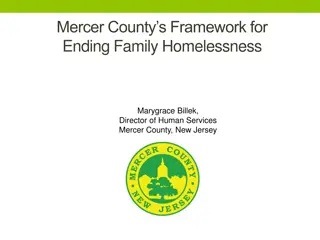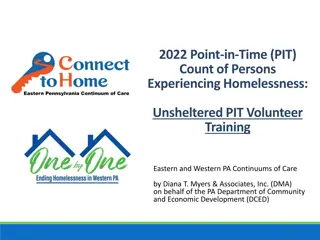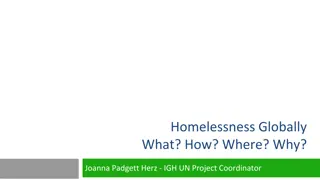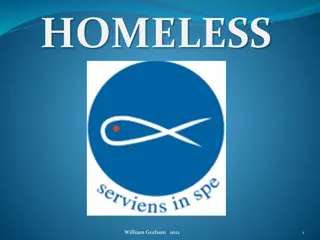Understanding Point-in-Time Counts in Homelessness Assistance Programs
Point-in-Time (PIT) Counts are crucial annual assessments conducted by Continuums of Care (CoCs) to enumerate sheltered and unsheltered homeless individuals on a single night in January. This count aids in determining homelessness trends, identifying vulnerable populations, and guiding resource allocation for homeless assistance programs. The process involves street outreach, canvassing known locations, and post-count surveys to gather comprehensive data on homelessness. Changes in data standards, such as expanded gender response categories and enhanced youth surveys, aim to improve the accuracy and inclusivity of PIT Counts.
Download Presentation

Please find below an Image/Link to download the presentation.
The content on the website is provided AS IS for your information and personal use only. It may not be sold, licensed, or shared on other websites without obtaining consent from the author. Download presentation by click this link. If you encounter any issues during the download, it is possible that the publisher has removed the file from their server.
E N D
Presentation Transcript
What is a Point in Time Count? The Point-in-Time (PIT) Count is a count of sheltered & unsheltered homeless persons on a single night in January. HUD requires that CoCs conduct an annual count of homeless persons who are in emergency shelter, transitional housing, and Safe Havens on a single night as well as unsheltered (places not meant for human habitation).
How the Count will be Administered Will occur on Wednesday, January 24, 2017. The day of the Count street outreach will ask people who were outdoors where they will be sleeping that night. Canvassing confirms this the evening of the count. Several volunteers will go out the evening of the Count and canvass the Counties (mainly known locations: bridges, encampments, transportation centers, hospitals, etc.).
The Next Day Soup Kitchens, Youth Drop-in Centers, and Day Programs will survey people to determine if slept in places not meant for human habitation the night before. We will then check against HMIS to confirm whether or not these individuals were in shelter the night of the Count.
Last Years Count HMIS reported that there were 532 individuals residing in shelters and/or hotels that evening. This was down from 563 from 2016. 49 unaccompanied youth were in shelter (9 under 18 years of age, 40 youth 18-24 years old). Chronic Homelessness decreased by 31% from 2016 43 People (1 unsheltered). 28 Unsheltered; most of who we found in Onondaga County and in 24 hour locations. Veteran population in Emergency Shelter decreased by 16% (21 Vets in shelter).
New PIT Count Changes 2017 HUD Data Standards changes: 1. Gender response categories expanded; SSVF, GPD, HOPWA, and RHY Assessment changes; Permanent Supportive Housing Housing Move in Date., etc. HUD limiting the collection of domestic violence information to those who are currently fleeing domestic/dating violence, sexual assault, or stalking. CoCs are now required to report on the number of children of parenting youth families where the parent is under the age of 18 separate from the children of parenting youth families where the parent is aged 18 to 24.
McKinney-Vento Homeless Youth Count Survey will be distributed in schools and local youth centers to ask homeless youth where they stayed last night. Will give us a better understanding of youth experiencing homelessness who are not meeting the HUD homeless definition. Data collection will separate unaccompanied youth from youth who are still with parent/guardian.
Volunteers? For Onondaga, please contact Melissa Marrone Email: mmarrone@unitedway-cny.org Office: 315-428-2216 or cell: 315-491-5328 For Oswego, please contact Kristin LaBarge Email: klabarge@oco.org Office: 315-598-4717 x1078 For Cayuga, please contact Chrissie Thornton or Renee Jensen Email: cthornton@chapelhouseshelter.org or rjensen@auburnny.gov Office: 315-252-0916 or 315-255-4115
Housing Inventory Count An inventory of housing conducted annually during the last ten days in January (same date as the PIT Count). Tallies the number of beds and units available on the night designated for the count by program type (emergency shelter, transitional housing, permanent housing), and include beds dedicated to serve persons who are homeless. Includes beds that are coming online within the next year, but they are marked as under-construction; i.e. Salvation Army Women s Shelter/Permanent Housing.
New HIC Changes 2017 HUD Data Standards Changes allow most communities to be able to easily upload the HIC into the HUD HDX. Department of Veteran Affairs recently designated components within their Grant Per Diem (GPD) program. They must report their GPD Projects by component type and project type. Federal Funding Sources were updated in the 2017 HUD Data Standards.



